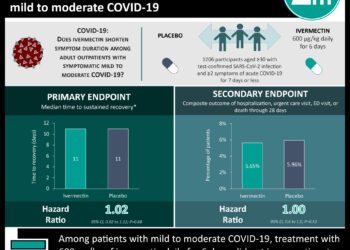Screening program aids in safe ivermectin distribution in Loa loa endemic areas
1. The LoaScope, a mobile phone compatible device, accurately identified persons with high levels of circulating Loa loa (L. loa) microfilaremia who are at risk to suffer a serious adverse event from ivermectin therapy.
2. No hospitalizations or deaths secondary to ivermectin treatment were reported, and risk factors identified for ivermectin related adverse events included older age, higher circulating levels of L. loa microfilariae, and antibodies to the Onchocerca Ov16 antigen (Ov16 IgG4+).
Evidence Rating Level: 2 (Good)
Study Rundown: Helminth infections such as Loa loa and Onchocerca volvulus are endemic in some parts of the world and cause significant disease burden. Ivermectin is an effective treatment for these parasites, but previous community-wide ivermectin distribution efforts in L. loa endemic areas have been hampered by serious adverse events, including encephalopathy and death, in persons with high circulating levels of L. loa microfilariae. To detect at-risk persons this study screened participants using the LoaScope, a point-of-care tool used with mobile phones that can quantify L. loa microfilaremia in pinprick blood samples. This screening and treatment program of over 15,000 participants resulted in no serious treatment related adverse events or deaths. The LoaScope screening tool was highly accurate when compared to manual microscopy.
This uncontrolled prospective study demonstrated how a test-and-not-treat strategy can enable safe community-wide ivermectin distribution. Strengths include the enrollment of participants from multiple health areas, thorough identification of adverse events, and the use of a strong reference standard for evaluation of the test. Limitations include the lack of a control arm, which limits estimation of the causal effect of this treatment strategy on reduction of adverse events.
Click to read the study, published in NEJM
Relevant Reading: Point-of-care quantification of blood-borne filarial parasites with a mobile phone microscope
In-Depth [prospective cohort]: This test-and-not-treat study evaluated 16 259 persons for L. loa microfilaremia prior to treatment with ivermectin. Participants were age 5 or older from 6 L. loa endemic areas in Cameroon. Patients with a L. loa microfilarial density below a specified threshold were treated with ivermectin, those above the threshold were given albendazole (for deworming), and pregnant patients were given folate and iron. Adverse events were monitored for up to 6 days after treatment.
Amongst all individuals tested, 15 552 (95.5%) were treated with ivermectin, and 340 (2.1%) were excluded from treatment due to microfilaremia above the threshold. Serious neurologic adverse events and deaths would have been anticipated in 62 and 8 people in this cohort, respectively, given prior incidence rates, but none were recorded in this study. The most common adverse events were pruritus (n = 564) and asthenia (n = 389), with adverse events were reported in 6.0% of all treated patients. Risk factors associated with adverse events to treatment included older age (p < 0.001), Ov16 IgG4+ status (p < 0.001), and higher circulating L. loa microfilarial density (p < 0.001). The reference standard for the LoaScope test was thick blood smear microscopy, and the LoaScope was found to have a specificity of 99.7% (95%CI, 99.6 to 99.8) and negative predictive value of 99.7% (95%CI, 99.6 to 99.7) for detection of individuals with low L. loa microfilariae density.
Image: PD/CDC
©2017 2 Minute Medicine, Inc. All rights reserved. No works may be reproduced without expressed written consent from 2 Minute Medicine, Inc. Inquire about licensing here. No article should be construed as medical advice and is not intended as such by the authors or by 2 Minute Medicine, Inc.







